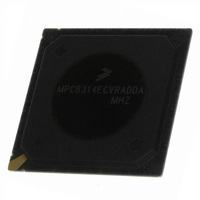MPC8314ECVRADDA Freescale Semiconductor, MPC8314ECVRADDA Datasheet - Page 53

MPC8314ECVRADDA
Manufacturer Part Number
MPC8314ECVRADDA
Description
MPU POWERQUICC II PRO 620-PBGA
Manufacturer
Freescale Semiconductor
Datasheet
1.MPC8314VRADDA.pdf
(106 pages)
Specifications of MPC8314ECVRADDA
Processor Type
MPC83xx PowerQUICC II Pro 32-Bit
Speed
266MHz
Voltage
1V
Mounting Type
Surface Mount
Package / Case
620-PBGA
Processor Series
MPC8xxx
Core
e300
Data Bus Width
32 bit
Maximum Clock Frequency
50 MHz
Maximum Operating Temperature
+ 105 C
Mounting Style
SMD/SMT
Minimum Operating Temperature
- 40 C
Lead Free Status / RoHS Status
Lead free / RoHS Compliant
Features
-
Lead Free Status / Rohs Status
Lead free / RoHS Compliant
Available stocks
Company
Part Number
Manufacturer
Quantity
Price
Company:
Part Number:
MPC8314ECVRADDA
Manufacturer:
Freescale Semiconductor
Quantity:
135
Company:
Part Number:
MPC8314ECVRADDA
Manufacturer:
Freescale Semiconductor
Quantity:
10 000
between 500 mV and –500 mV, in other words, V
phase. The peak differential voltage (V
is 1000 mV p-p.
15.2
The SerDes reference clock inputs are applied to an internal PLL whose output creates the clock used by
the corresponding SerDes lanes. The SerDes reference clocks input is SD_REF_CLK and SD_REF_CLK
for PCI Express and SGMII interface.
The following sections describe the SerDes reference clock requirements and some application
information.
15.2.1
Figure 38
Freescale Semiconductor
•
•
•
•
The supply voltage requirements for XCOREVDD are specified in
SerDes Reference Clock Receiver Reference Circuit Structure
— The SD_REF_CLK and SD_REF_CLK are internally AC-coupled differential inputs as shown
— The external reference clock driver must be able to drive this termination.
— The SerDes reference clock input can be either differential or single-ended. Refer to the
The maximum average current requirement that also determines the common mode voltage range
— When the SerDes reference clock differential inputs are DC coupled externally with the clock
— This current limitation sets the maximum common mode input voltage to be less than 0.4V
— If the device driving the SD_REF_CLK and SD_REF_CLK inputs cannot drive 50 ohms to
The input amplitude requirement
— This requirement is described in detail in the following sections.
SerDes Reference Clocks
shows a receiver reference diagram of the SerDes reference clocks.
in
termination to XCOREVSS followed by on-chip AC-coupling.
Differential Mode and Single-ended Mode description below for further detailed requirements.
driver chip, the maximum average current allowed for each input pin is 8mA. In this case, the
exact common mode input voltage is not critical as long as it is within the range allowed by the
maximum average current of 8 mA (refer to the following bullet for more detail), since the
input is AC-coupled on-chip.
(0.4V/50 = 8mA) while the minimum common mode input level is 0.1V above XCOREVSS.
For example, a clock with a 50/50 duty cycle can be produced by a clock driver with output
driven by its current source from 0mA to 16mA (0-0.8V), such that each phase of the
differential input has a single-ended swing from 0V to 800mV with the common mode voltage
at 400mV.
XCOREVSS DC, or it exceeds the maximum input current limitations, then it must be
AC-coupled off-chip.
SerDes Reference Clock Receiver Characteristics
Figure
MPC8314E PowerQUICC
38. Each differential clock input (SD_REF_CLK or SD_REF_CLK) has a 50-Ω
DIFFp
™
II Pro Processor Hardware Specifications, Rev. 0
) is 500 mV. The peak-to-peak differential voltage (V
OD
is 500 mV in one phase and –500 mV in the other
Table 1
High-Speed Serial Interfaces (HSSI)
and
Table
2.
DIFFp-p
53
)











